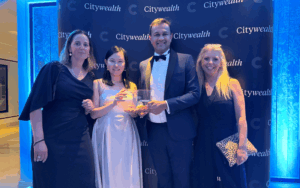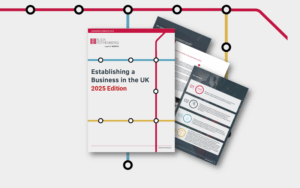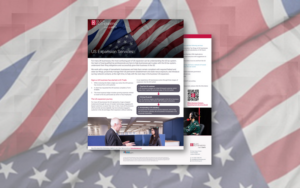Committed to helping everyone achieve their full potential

Gender Pay Gap Report 2023
Gender Pay Gap Report for April 2023
As set out in Blick Rothenberg’s Pathway, our five-year strategy, we are committed to improving the diversity of our workforce across all levels by building a culture that’s genuinely inclusive where everyone can fulfil their potential and individuality is celebrated.
- The UK Government requires all employers with 250 or more employees to annually disclose their gender pay gap using the following metrics:
- Mean gender pay gap using hourly pay
- Median gender pay gap using hourly pay
- Mean bonus gender pay gap
- Median bonus gender pay gap
- Proportion of men and women receiving bonuses
- Proportion of men and women in each pay quarter
Accordingly, we are sharing our gender pay and bonus gap figures which continue to help us understand how the average earnings of male and female employees working at BR differ.
The data in our gender pay analysis is a snapshot at 5 April 2023, and has been calculated using the standard methodologies set out in the Equality Act 2010 (Gender Pay Gap Information) Regulations 2017.
Understanding Gender Pay
The gender pay gap is not the same as equal pay. Equal pay is about ensuring that men and women performing the same or equivalent work are paid the same, whereas the gender pay gap is a statistical calculation which looks at the difference between the average salaries of all females and all males across the organisation.
Our Gender Pay and Bonus Gap Data:
| Year | Mean hourly pay gender pay gap | Median hourly pay gender pay gap |
| BR April 2022 | 22.67% | 12.76% |
| BR April 2023 | 19.66 % (down 3.01%) | 8.42% (down 4.34%) |
| Year | Mean bonus gender pay gap | Median bonus gender pay gap |
| BR April 2022 | 55.35% | 9.97% |
| BR April 2023 | 58.11% (up 2.76%) | 30.00% (up 20.03%) |
Pay quarters
The percentage of men and women in each hourly pay quarter (this is the percentage of men and women in 4 equally sized groups, ranked from highest to lowest hourly pay).
There are 159 people in each quarter.
| Upper Pay Quarter | 2022 | 2023 |
| % Men | 62% | 59.75% |
| % Women | 38% | 40.25% |
| Upper Middle Pay Quarter | ||
| % Men | 55.33% | 54.72% |
| % Women | 44.67% | 45.28% |
| Lower Middle Pay Quarter | ||
| % Men | 30.34% | 46.54% |
| % Women | 69.66% | 53.46% |
| Lower Pay Quarter | ||
| % Men | 52.32% | 54.38% |
| % Women | 47.68% | 45.63% |
Bonus recipients
Proportion of males and females receiving bonuses:
| Percentage of men and women receiving a bonus | ||
| 2022 | 2023 | |
| Women receiving a bonus | 230 | 201 |
| Women without a bonus | 52 | 93 |
| Men receiving bonus | 252 | 242 |
| Men without a bonus | 67 | 101 |
| Total Number of Men | 319 | 343 |
| Total Number Women | 282 | 294 |
| % of Men with bonus | 79.00% | 70.55% |
| % of Women with bonus | 81.56% | 68.37% |
Key headlines for 2023
Blick Rothenberg has a mean hourly pay gender pay gap of 19.66% and a median hourly pay gender pay gap of 8.42%. We have seen positive movement since our last report with a reduction of 3.01% to our mean hourly pay gender pay gap and a reduction of 4.34% to our median hourly pay gender pay gap.
However, we have seen an increase in our mean bonus gender pay gap at 58.11% (up 2.76% from 2022). The mean bonus gender pay gap compares the average male bonus to the average female bonus overall. This means that when looking at all men and women who received a bonus in BR, the average payment for males was higher than it was for females.
Our median bonus gender pay figure has also increased to 30% (up 20.03% from 2022). The median is calculated by ordering all bonus payments for females and males separately in ascending order and selecting the middle number from each list.
The increase in our gender mean and median bonus pay gaps can be explained by the structure of our workforce with a greater number of men in our Partner and more senior roles than women at 5 April 2023 and bonus represents a higher proportion of total remuneration for this group. During the last reporting period we also made more male than female lateral hires at Partner level.
It is worth noting that, unlike comparable firms, Blick Rothenberg is a Limited Company and as a result, all those in Partner roles are employees and are therefore included in our calculations whereas typically in a partnership they would be excluded.
However, we have carried out some additional analysis and calculated the gender pay and bonus pay gap figures removing data for Partners. This shows BR has a minus mean hourly pay gender pay gap (meaning females are on average paid higher than males) at -2.19%, and a median hourly pay gender pay gap of -2.73%, and a smaller mean bonus gender pay gap of 9.33% and a median bonus gender pay gap of 6.67%.
What are we doing to close our gender pay gap?
Blick Rothenberg is committed to closing our gender pay and bonus gaps and we recognise that to do this we need to increase the number of women in the most senior roles.
Over the past year we have:
- Aimed to improve the attraction to and retention of women in our organisation by improving our parental policies. We have increased our paternity leave and pay as well as our maternity leave and pay. We have also put support in place for those experiencing fertility challenges and pregnancy loss.
- Provided a diversity review of our salary, bonus and talent review processes which has helped us make fairer decisions regarding pay, bonus, and promotions. We have also launched our new reward strategy which has a focus on transparency and consistency.
- Asked our Partners to set a performance objective related to inclusion and diversity, which has encouraged them to think and act differently to champion change.
- Equipped all our Partners with the skills, knowledge and behaviours to lead inclusively through our inclusive leadership development programme.
- Continued to embed our BRighter Working framework which helps people balance how, when and where they work. The framework ensures we can meet the needs of our colleagues, clients and our own needs to create more flexibility, stretch and autonomy.
- Started to collect data to help us analyse and report on the diversity of our workforce. This has helped us have a better understanding of where our initiatives are succeeding, and where our efforts need to be focused for better future outcomes.
However, we recognise to achieve change, we must ensure that inclusion and diversity are embedded across our entire employee lifecycle, from attraction and recruitment, to pay and equal access to training and opportunities.
Given our gender pay and bonus gaps are driven by having more men at senior levels where salaries and bonuses are typically higher, our new inclusion and diversity strategy will specifically focus on addressing some of these issues.
Looking forward we will be:
- Launching a new Director Development Programme which will aim to support the development and progression of our Director population.
- Conducting an end-to-end review of our attraction and recruitment process, which will have a particular focus on the process for Partner recruitment.
- Putting in place a skills development programme (People Manager Evolution) for all our People Managers which will have a focus on inclusion.
- Putting in place a coach development programme, a key cornerstone of our wider people strategy, which will transform the way we lead, manage and interact with all our people.
“In an industry where numbers are our focus, we believe success is a people business, reflected by our purpose to improve the lives of our colleagues, clients and communities in a sustainable way. Everyone at Blick Rothenberg contributes to this purpose.
Closing our Gender Pay Gap requires long term, sustainable action. To do this, it is essential that we attract, develop and retain smart talented people as well as provide a culture where everyone can fulfil their potential.
We welcome the transparency of annual reporting as it drives accountability and promotes conversation and action.
Jez Filley, Head of Audit, Assurance and Outsourcing, and Leadership Team Sponsor for Inclusion and Diversity
I confirm the data reported is accurate and has been calculated according to the legal requirements.
Nimesh Shah, Chief Executive Officer
Published: 21 March 2023















